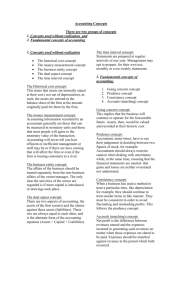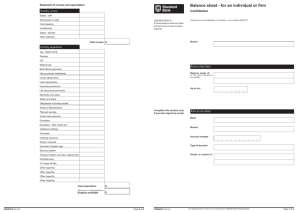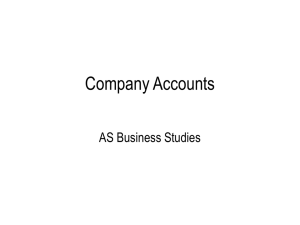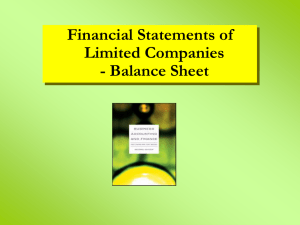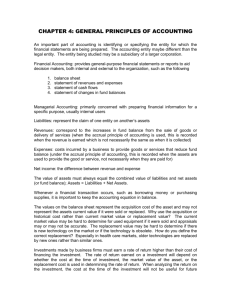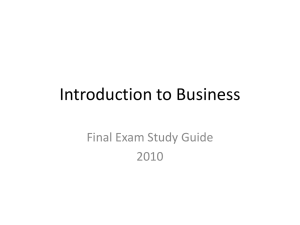Community Financial Report
advertisement
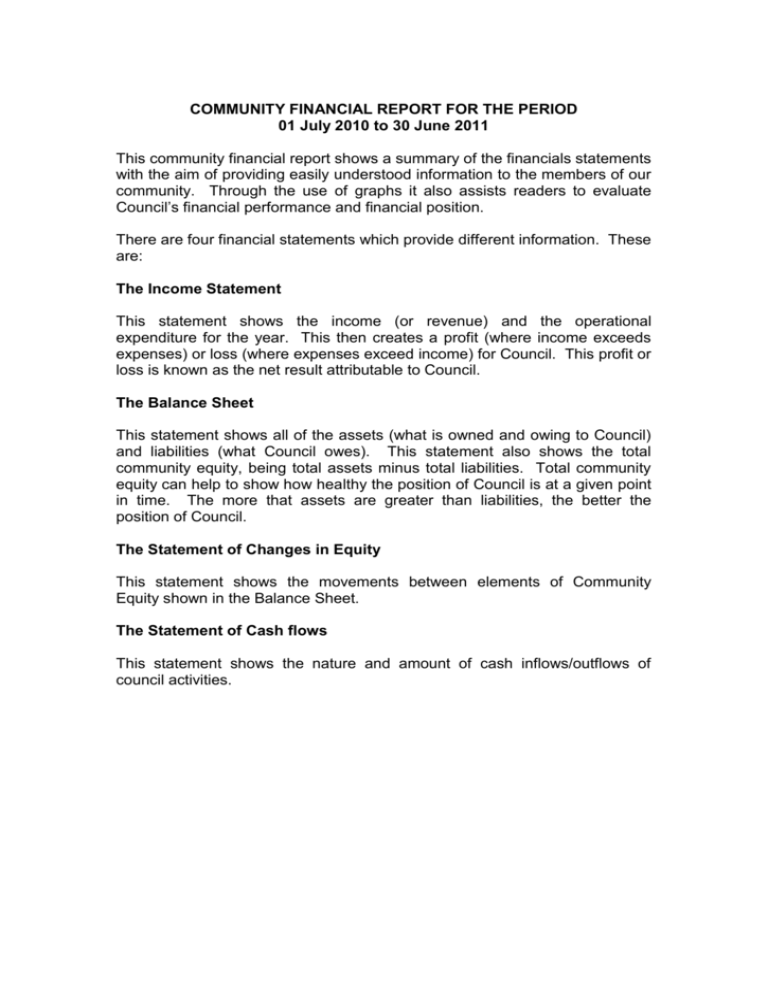
COMMUNITY FINANCIAL REPORT FOR THE PERIOD 01 July 2010 to 30 June 2011 This community financial report shows a summary of the financials statements with the aim of providing easily understood information to the members of our community. Through the use of graphs it also assists readers to evaluate Council’s financial performance and financial position. There are four financial statements which provide different information. These are: The Income Statement This statement shows the income (or revenue) and the operational expenditure for the year. This then creates a profit (where income exceeds expenses) or loss (where expenses exceed income) for Council. This profit or loss is known as the net result attributable to Council. The Balance Sheet This statement shows all of the assets (what is owned and owing to Council) and liabilities (what Council owes). This statement also shows the total community equity, being total assets minus total liabilities. Total community equity can help to show how healthy the position of Council is at a given point in time. The more that assets are greater than liabilities, the better the position of Council. The Statement of Changes in Equity This statement shows the movements between elements of Community Equity shown in the Balance Sheet. The Statement of Cash flows This statement shows the nature and amount of cash inflows/outflows of council activities. THE INCOME STATEMENT Revenue – where did the dollars come from? Sources of Revenue Rates, levies and charges 0.08% Fees and charges 8.76% Capital grants, subsidies, Contributions, and donations 9.37% Rental income 5.94% Interest received 0.37% Sales revenue 12.82% Grants, subsidies, Contributions, and donations 62.20% Other income 0.45% Council received $60 million in revenue during 2010/2011. This was primarily from Grants, Subsidies, Contributions and Donations of $37 million which accounted for 62% of total revenue. Capital grants made up 9% of revenue. The remaining revenue is sourced from interest revenue, rental income, fees and sales revenue. Expenses – where the dollars were spent? Expenditure by Type Depreciation and amortisation 27.14% Employee benefits 27.28% Finance costs 0.46% Materials and services 45.12% Total expenses of $76 million were incurred during July 2010 and June 2011, which were primarily for employee costs of $21 million and materials and services of $34 million which together made up 72% of total expenditure. The remaining expenditure is made up of depreciation and amortisation and finance costs. Net Result attributable to Council Financial Performance - Net Result 600 500 Millions 400 300 200 100 0 2008/09 2009/10 2010/11 -100 The net result is the difference between revenue received and the operating expenses incurred by Council throughout the year on an accrual basis. The 2010/2011 net result is $-16.2 million which indicates that revenue is $16.2 million less than expenses. Therefore, the surplus is not actual cash, but rather fixed assets in the form of, for example – water and sewage treatment plants, roads and buildings. Operating Position Financial Performance - Net Operating Position 0 2008/09 -5 Millions -10 -15 -20 -25 -30 -35 2009/10 2010/11 The operating position is calculated by taking total operating expenditure from the total operating revenue. Operating revenue in this calculation does not include any revenue for capital projects. In many ways the operating position is the best measure of Council’s financial performance in a given year. The operating position gives an indication of Council’s ability to continue operating at sustainable levels, as well as Councils ability to fund the future acquisition and replacement of assets. The Council is showing a loss level in terms of operating position, principally due to recognition of depreciation (or consumption of assets). THE BALANCE SHEET Assets – what we own and what is owing to us Assets at 30 June 2011 Cash and cash equivalents 0.82% Trade and other receivables 1.69% Inventories 0.07% Property, plant and equipment 97.42% The major components of assets include property, plant and equipment, land, roads, water and sewerage, housing and cash assets. These assets represent 98% of all assets. Cash Position 18 16 14 Millions 12 10 8 6 4 2 0 -2 2008/09 2009/10 2010/11 -4 Cash position at year end Unrestrcited cash balance The cash position at 30 June 2011 was $6.3 million. The unrestricted cash balance (total cash less constrained grant funds) was $-1.6 million. Liabilities – what we owe Liabilities at 30 June 2011 Provisions 25.00% Trade and other payables 70.92% Borrowings 4.08% Council’s liabilities include loans, amounts owing to suppliers, and amounts owing to employees for leave entitlements. Total liabilities at 30 June 2011 were $13.2 million. QUEENSLAND TREASURY DEBT Council’s current borrowing policy requires: - No use of long term debt to finance operating activities or recurrent expenditure; - Priority will be given in any borrowing program to income producing assets; These borrowings are repaid on a monthly basis in accordance with the terms and conditions set by the Queensland Treasury Corporation. The repayment terms are reviewed on a regular basis in order to ensure that the expected loan term aligns with market movements. Debt Per House 800 700 Dollars 600 500 400 300 200 100 0 2008/09 2009/10 2010/11 The debt per community house is $555 at 30 June 2011. CONCLUSION At 30 June 2011, Torres Strait Island Regional Council recorded a substantial operating deficit. This deficit was principally driven by the recognition of depreciation in the accounts. At present, the revenue streams of Council are not adequate to cover the operational costs (including depreciation) of Council. FINANCIAL MANAGEMENT SUSTAINABILITY The Queensland Department of Infrastructure and Planning has published a Financial Management (Sustainability) Guideline. The Department has defined sustainability in the Queensland Local Government sector as: A local council is sustainable if its infrastructure capital and financial capital is able to be maintained over the long term. The Department has published a number of Financial Ratios as measures of sustainability. Financial ratios provide a useful snapshot of Council’s status. These ratios are calculated by dividing a dollar amount of one item reported in the financials statements by the dollar amount of another. The result is a relationship between two related items that is easy to interpret and is also useful in comparing Torres Strait Island Regional Council to other Councils. Sustainability Indicators Ratio Working Capital Ratio Calculation Current Assets _____________________ Current Liabilities Operating Surplus Ratio Net Operating Surplus ______________________ Information This is an indicator of the management of working capital. Measures the extent to which a council has liquid assets available to meet short term financial obligations. Target Greater than 1:1 Actual 2:2 This is an indicator of the extent to which revenues Between 0% and 15% raised covers operational expenses or are available for capital funding. -26.83% This is an indicator of the extent to which the net financial liabilities of council can be serviced by its operating revenues. Not Greater than 60% -11.49% This ratio indicates the extent to which council's operating revenues are committed to interest expense. Between 0% and 10% 0.06% Total Operating Revenue Net Financial Liabilities Ratio Total Liabilities - Current Assets __________________________ Total Operating Revenue Interest Coverage Ratio Net Interest Expense on Debt __________________________ Total Operating Revenue Sustainability Indicators Ratio Asset Sustainability Ratio Asset Renewal Funding Ratio Calculation Information Capital Expenditure on Replacement Assets This is an approximation of the extent to which the infrastructure assets are being replaced as they reach __________________________________ the end of their useful lives. Depreciation Expense Net Present Value of Planned Capital Expenditure on Renewals over 10 years ______________________________ Net Present Value of Required Capital Expenditure on Renewals Target Greater than 90% This represents the extent to which the required capital Greater than 90% expenditures on renewals have been incorporated into the 10 Year Financial Model of Council. Actual 70.87% Due to Grant Funding uncertaintly it is not possible to calculate this indicator. This Community Financial Report and Financial Sustainability Indicator Report has been compiled in accordance with: Local Government Finance Standard 2005 s.23(1)/(2)(b): (1) (2) This section states particular matters that a local government’s annual report for a financial year must contain. The matters are – (b) a community financial report that is – (3) (i) consistent with, but not part of, the local government’s financial statements: and (ii) in a form that is readily understood by the community. In this section – “community financial report” means a report containing a summary and analysis of the local government’s financial performance and position for the financial year.

